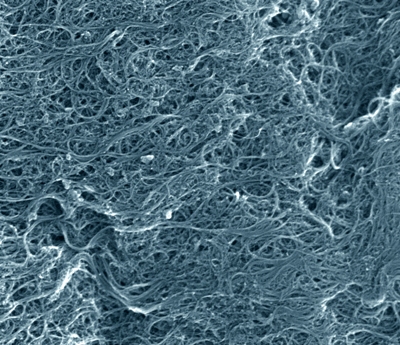Nov 16 2012
Researchers at the National Institute of Standards and Technology (NIST) have provided evidence in the laboratory that single-wall carbon nanotubes (SWCNTs) may help protect DNA molecules from damage by oxidation.
 Scanning electron microscope image of a typical sample of the NIST single-wall carbon nanotube soot standard reference material. Recent NIST research suggests that, at least in the laboratory, carbon nanotubes may help protect DNA molecules from damage by oxidation. The image shows an area just over a micrometer wide. (Color added for clarity.) (Credit: Vladar, NIST)
Scanning electron microscope image of a typical sample of the NIST single-wall carbon nanotube soot standard reference material. Recent NIST research suggests that, at least in the laboratory, carbon nanotubes may help protect DNA molecules from damage by oxidation. The image shows an area just over a micrometer wide. (Color added for clarity.) (Credit: Vladar, NIST)
In nature, oxidation is a common chemical process in which a reactive chemical removes electrons from DNA and may increase the chance for mutations in cells. More studies are needed to see if the in vitro protective effect of nanotubes reported in the laboratory also occurs in vivo, that is, within a living organism.
"Our findings don't tell us whether carbon nanotubes are good or bad for people and the environment," says Elijah Petersen, one of the authors of the study. "However, the results do help us better understand the mechanisms by which nanotubes might interact with biomolecules."
Single-wall carbon nanotubes—tiny hollow rods that are one-atom-thick sheets of graphene rolled into cylinders 10,000 times smaller in diameter than a human hair—are prized for their extraordinary optical, mechanical, thermal and electronic properties. They are being used to produce lightweight and extremely strong materials, enhance the capabilities of devices such as sensors, and provide a novel means of delivering drugs with great specificity. However, as carbon nanotubes become increasingly incorporated into consumer and medical products, the public concern about their potential environmental, health and safety (EHS) risks has grown. Scientifically determining the level of risk associated with the carbon nanotubes has been challenging, with different studies showing conflicting results on cellular toxicity. One of the components lacking in these studies is an understanding of what physically happens at the molecular level.
In a recent paper,* NIST researchers investigated the impact of ultrasonication on a solution of DNA fragments known as oligomers in the presence and absence of carbon nanotubes. Ultrasonication is a standard laboratory technique that uses high-frequency sound waves to mix solutions, break open cells or process slurries. The process can break water molecules into highly reactive agents such as hydroxyl radicals and hydrogen peroxide that are similar to the oxidative chemicals that commonly threaten mammalian cell DNA, although the experimental levels from sonication are much greater than those found naturally within cells. "In our experiment, we were looking to see if the nanotubes enhanced or deterred oxidative damage to DNA," Petersen says.
Contrary to the expectation that carbon nanotubes will damage biomolecules they contact, the researchers found that overall levels of accumulated DNA damage were significantly reduced in the solutions with nanotubes present. "This suggests that the nanotubes may provide a protective effect against oxidative damage to DNA," Petersen says.
A possible explanation for the surprising result, Petersen says, is that the carbon nanotubes may act as scavengers, binding up the oxidative species in solution and preventing them from interacting with DNA. "We also saw a decrease in DNA damage when we did ultrasonication in the presence of dimethyl sulfoxide (DMSO), a chemical compound known to be a hydroxyl radical scavenger," Petersen says.
Petersen says that a third experiment where ultrasonication was performed in the presence of DMSO and SWCNTs at the same time produced an additive effect, reducing the DNA damage levels more significantly than either treatment alone.
This research is part of NIST's work to help characterize the potential EHS risks of nanomaterials, and develop methods for identifying and measuring them.